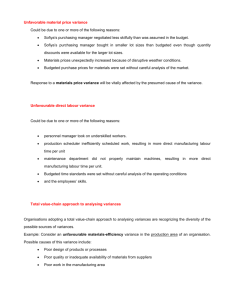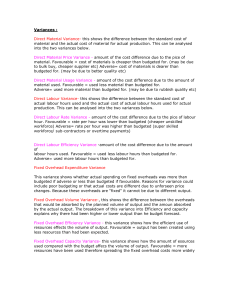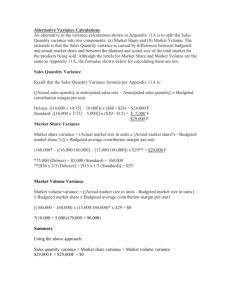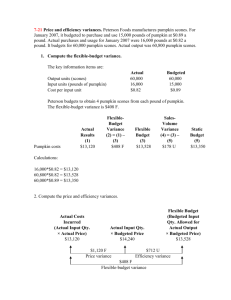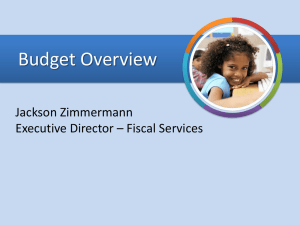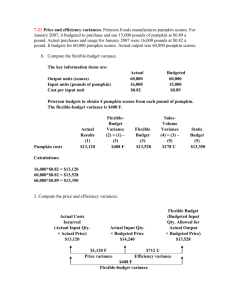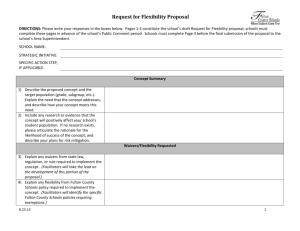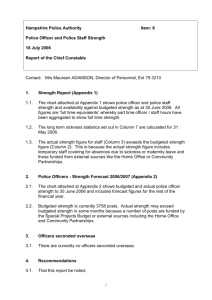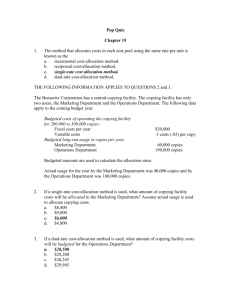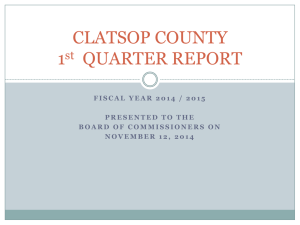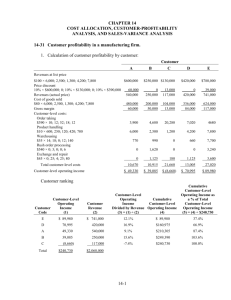Flexible budgeting and cost behaviours
advertisement
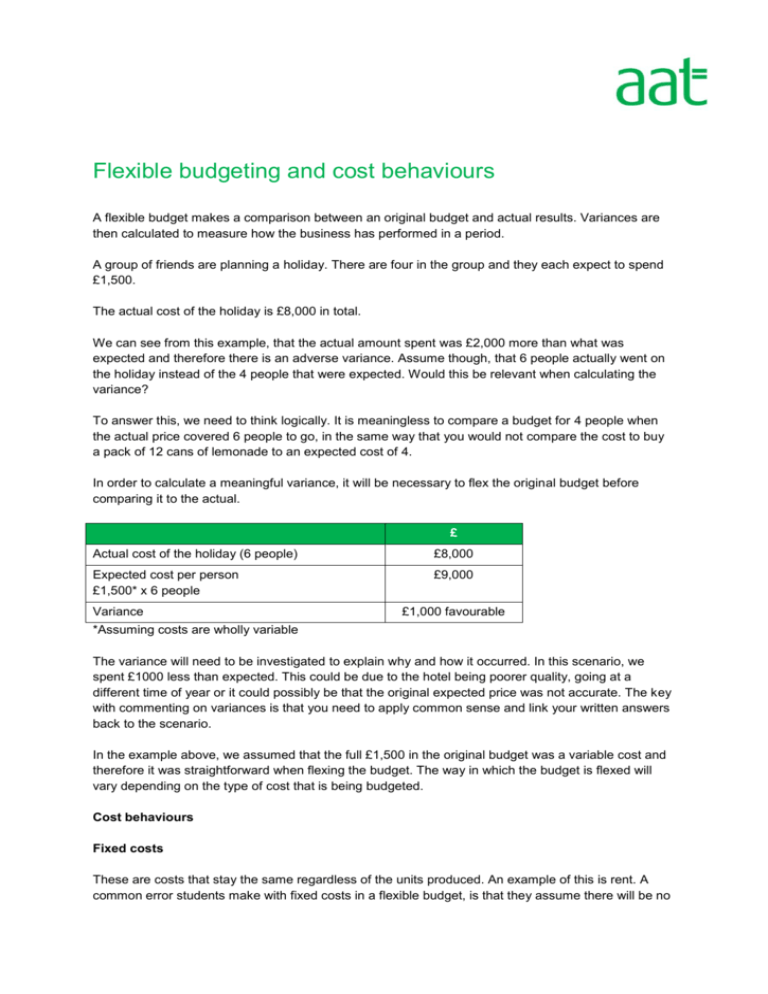
Flexible budgeting and cost behaviours A flexible budget makes a comparison between an original budget and actual results. Variances are then calculated to measure how the business has performed in a period. A group of friends are planning a holiday. There are four in the group and they each expect to spend £1,500. The actual cost of the holiday is £8,000 in total. We can see from this example, that the actual amount spent was £2,000 more than what was expected and therefore there is an adverse variance. Assume though, that 6 people actually went on the holiday instead of the 4 people that were expected. Would this be relevant when calculating the variance? To answer this, we need to think logically. It is meaningless to compare a budget for 4 people when the actual price covered 6 people to go, in the same way that you would not compare the cost to buy a pack of 12 cans of lemonade to an expected cost of 4. In order to calculate a meaningful variance, it will be necessary to flex the original budget before comparing it to the actual. £ Actual cost of the holiday (6 people) £8,000 Expected cost per person £1,500* x 6 people £9,000 Variance £1,000 favourable *Assuming costs are wholly variable The variance will need to be investigated to explain why and how it occurred. In this scenario, we spent £1000 less than expected. This could be due to the hotel being poorer quality, going at a different time of year or it could possibly be that the original expected price was not accurate. The key with commenting on variances is that you need to apply common sense and link your written answers back to the scenario. In the example above, we assumed that the full £1,500 in the original budget was a variable cost and therefore it was straightforward when flexing the budget. The way in which the budget is flexed will vary depending on the type of cost that is being budgeted. Cost behaviours Fixed costs These are costs that stay the same regardless of the units produced. An example of this is rent. A common error students make with fixed costs in a flexible budget, is that they assume there will be no variances, which will not always be the case. If a business budgets to pay £8,000 for the year for rent, this means that when the budget is prepared, the rent is expected to be £8,000 for rent regardless of how many units are expected to be made. However, the actual cost that the business pays for rent may be more, or less than the amount expected due to any changes that happened during the period, for example a new landlord or change of premises. Variable costs These are costs that vary with output. If the amount of units budgeted is different to the actual units produced then budgeted variable costs will need to be flexed to the actual units produced, as in the friend’s holiday example above, to calculate meaningful variances. The variable cost per unit remains constant at all levels of output, which means that if the business makes 10 units, the cost of making each unit would be the same as if they made 1,000 units. In real life, this is unlikely to be the case due to economies of scale. Semi-variable costs These costs contain both a fixed and variable element. When flexing the budget, the fixed and variable elements will need to be separated as these will follow the cost behaviour rules as above. The fixed element of the budgeted cost will not need to be flexed whereas the budgeted variable costs will need to be. A business prepared two labour budgets at the start of a period. They were unsure as to whether they would produce and sell 1,000 units or 1,200 units. Budgeted units Total labour cost £ For 1,000 units £12,000 For 1,200 units £14,000 The actual units produced and sold were 1,120 and the total actual labour cost was £13,250. We can see straight away that the budgeted units are not the same as the actual units, so we will need to consider flexing the budget to the actual units produced. Before we can flex the budget, we first of all need to determine the cost behaviour of the cost in question. Is it a fixed cost? No, the labour cost is not fixed as the total budgeted labour cost at 1,000 and 1,200 units is different. Is it a variable cost? To test whether a cost is variable, calculate the budgeted cost per unit at the two different activity levels. As mentioned earlier, a variable cost remains constant at all levels of output. £12,000 / 1,000 units = £12 per unit £14,000 / 1,200 units = £11.67 per unit The budgeted labour cost is therefore not variable. We will therefore assume it is a semi-variable cost. We will use the high–low method to first of all isolate the fixed and variable elements and then flex the variable element to the actual units produced, keeping the fixed element the same as budgeted. Using budgeted figures – high–low method Units Total cost £ 1. Highest 1,200 units £14,000 2. Lowest 1,000 units £12,000 200 units £2,000 3. Differences 4. Find the variable cost per unit Difference in total cost / difference in units = £2,000 / 200 units = £10 per unit Now the variable cost per unit is known, we are able to find the fixed element. We will check this at both levels of budgeted output to make sure that the fixed element is the same. 5. Find the fixed element Using highest Total cost = fixed cost + variable cost £14,000 = a + (1,200 x £10) £14,000 = a + £12,000 Fixed cost (a) = £2,000 Using lowest Total cost = fixed cost + variable cost £12,000 = a + (1,000 x £10) £12,000 = a + £10,000 Fixed cost (a) = £2,000 Now the fixed and variable elements are known, the budget can be flexed and compared to the actual units produced of 1,120 and a variance calculated. Stepped cost The last of our cost behaviours is a stepped cost. This is where a cost is fixed over a certain range of output, and then increases once output reaches a certain point. A business is preparing a budget for their supervisor’s salary. One supervisor can supervise 500 units being produced. Once output reaches 501 units an additional supervisor is required and once production reaches 1,001 units a third supervisor is required, and so on. Each supervisor is expected to earn £25,000 per year. The following budgets have been prepared for supervisor costs at different forecasted activity levels. Supervisor costs £ 600 £50,000 850 £50,000 1010 £75,000 1425 £75,000 1550 £100,000 1950 £100,000 2100 £125,000 2450 £125,000 3,100 units were actually produced at a cost of £182,500. 1. Firstly, calculate how many steps the actual units have climbed. The actual units are 3,100 and the steps are in ranges of 500 units, and therefore 3,100 falls within the 3,001–3,500 range = 7 steps. 0–500 = 1 step 501–1000 = 2 steps 1001–1500 = 3 steps 1501–2000 = 4 steps 2001–2500 = 5 steps 2501–3000 = 6 steps 3001–3500 = 7 steps 2. Compare the actual cost for 7 steps to a budget flexed to 7 steps. Supervisor’s salary Flexed budget Actual Variance £ 7 steps x £25,000 = £175,000 £182,500 £7,500 A The budgeting module requires you to determine cost behaviours using information and then to flex a budget, so that meaningful variances can be calculated as the budget and the actuals can be compared on a ‘like for like’ basis. A business produced the following two budgets at the start of the period. The actual results have also been provided. Prepare a flexible budget and state whether the variances are adverse or favourable. Show all figures as positive numbers. Click to display/hide the solution. Electricity is a semi-variable cost. Quality control is a stepped cost. The cost increases by £2,000 for each 500 units produced. Original budget Revised budget Actual Flexed budget Variance Adverse/ favourable 2,000 2,200 1,900 1,900 Sales revenue £200,000 £220,000 £185,000 £190,000 Materials £24,000 £26,400 £21,000 £22,800 £1,800 F Labour £18,000 £19,800 £16,000 £17,100 £1,100 F Variable £15,000 £16,500 £14,000 £14,250 £250 F Units A £5,000 overheads Electricity £22,000 £22,800 £20,000 £21,600 Quality control £10,000 £10,000 £10,000 £8,000 Fixed overheads £36,000 £36,000 £40,000 £36,000 Net profit £75,000 £1,600 F A £2,000 A £4,000 £88,500 £64,000 £70,250 The flexed budget figures are: Sales revenue £100 x 1,900 units = £190,000 Materials £12 x 1,900 units = £22,800 Electricity Units Total cost £ 1. Highest 2,200 units £22,800 2. Lowest 2,000 units £22,000 3. Differences 200 units £800 4. Find the variable cost per unit Difference in total cost / difference in units = £800 / 200 units = £4 per unit 5. Find the fixed element Using highest Total cost = fixed cost + variable cost £22,800 = a + (2,200 x £4) £22,800 = a + £8,800 Fixed cost (a) = £14,000 @ 1,900 units £14,000 + (1,900 x £4) = £21,600 Quality control Actual number of steps = 4 x budgeted cost per step £2,000 = £8,000 £6,250 A
